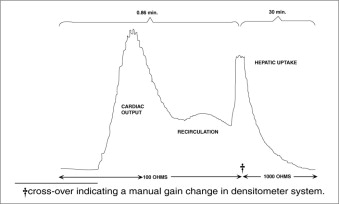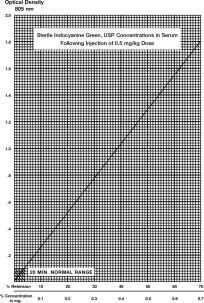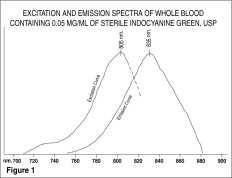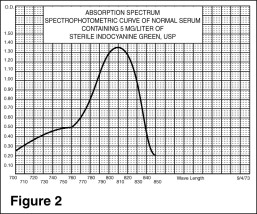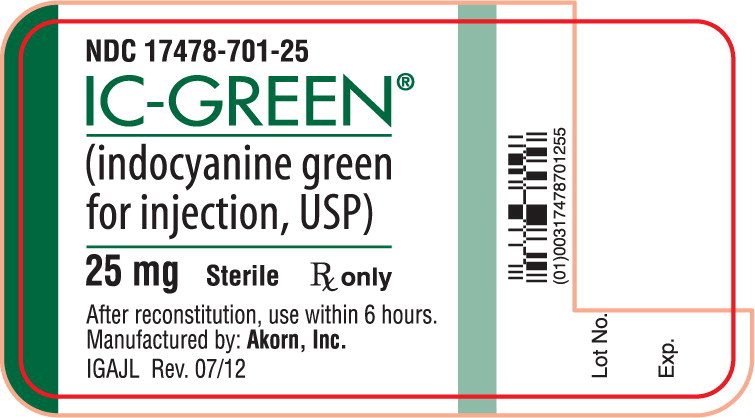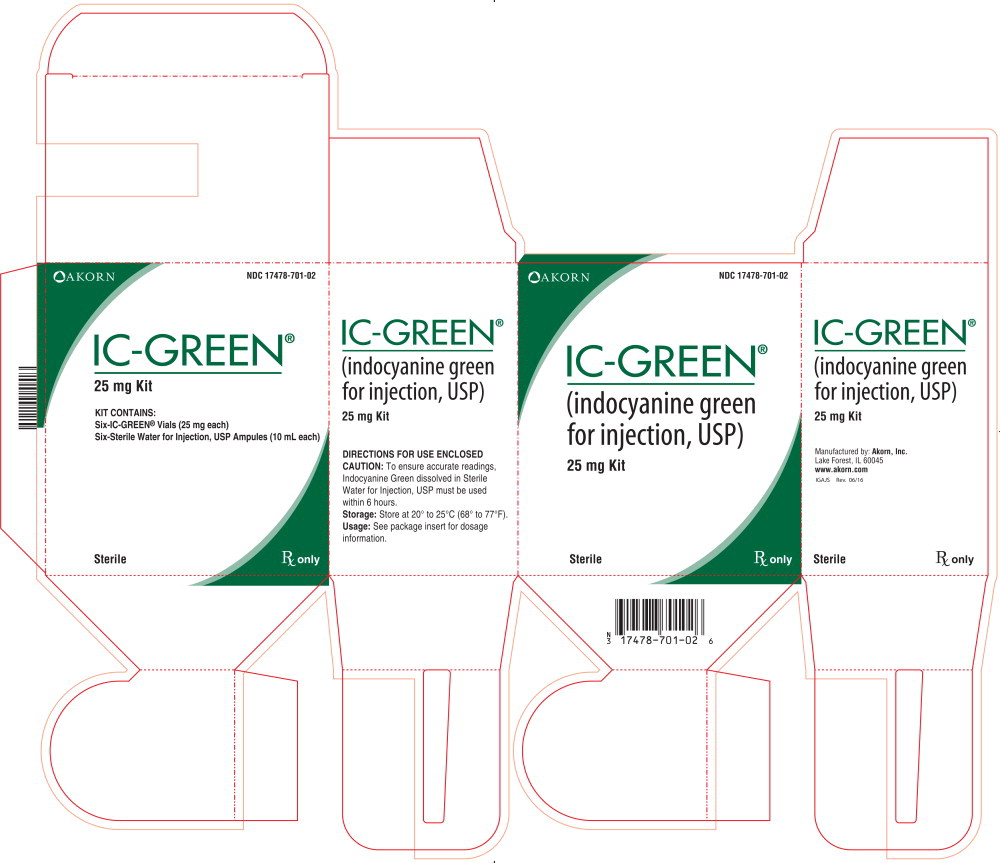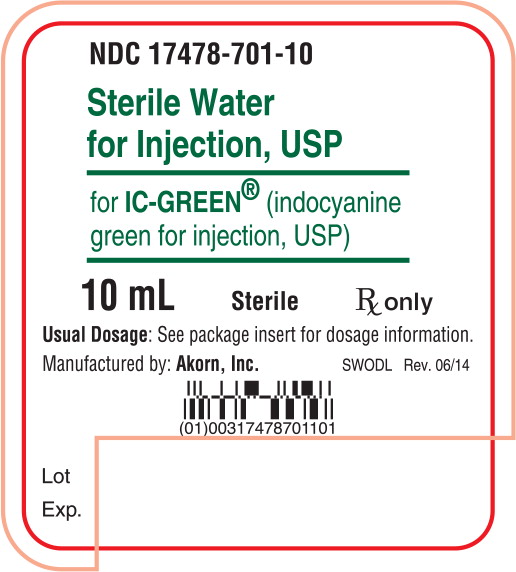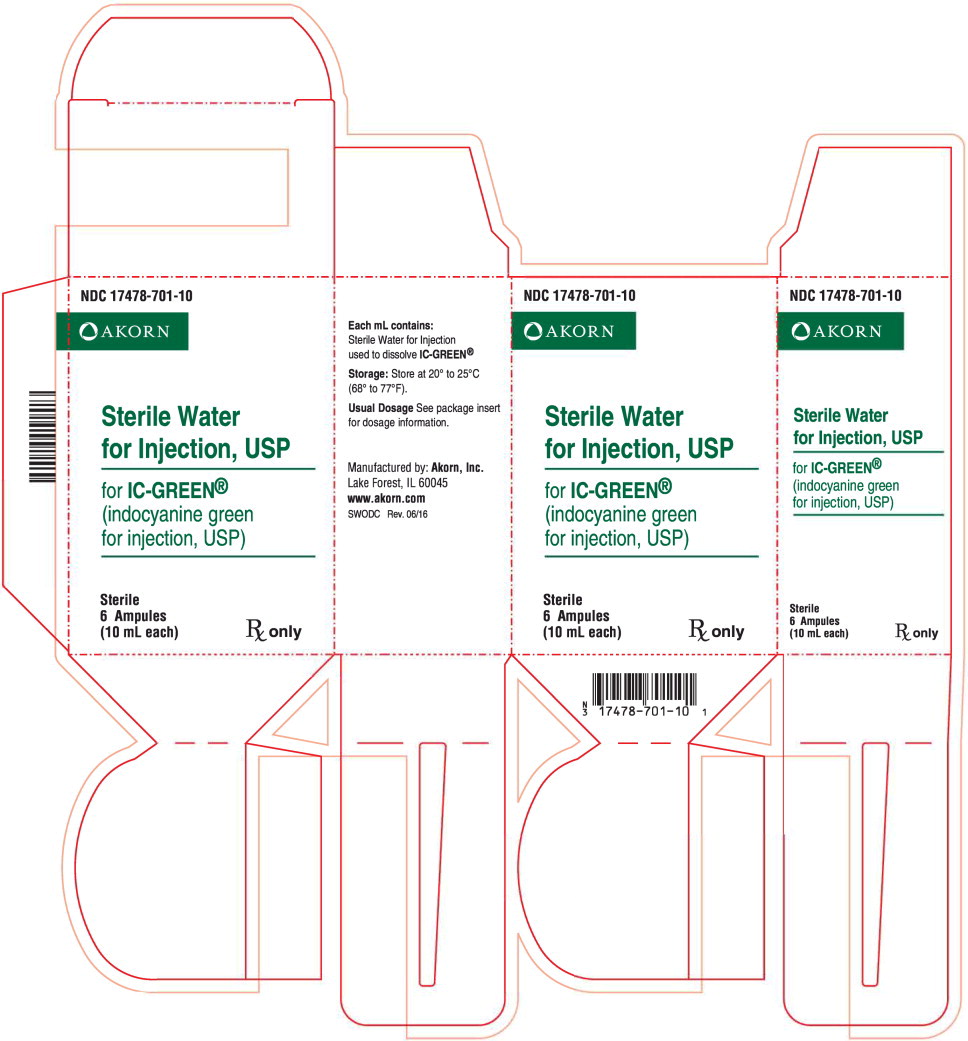IC-GREEN- indocyanine green kit
IC-Green by
Drug Labeling and Warnings
IC-Green by is a Prescription medication manufactured, distributed, or labeled by Akorn, Inc., Akorn Operating Company LLC. Drug facts, warnings, and ingredients follow.
Drug Details [pdf]
-
HIGHLIGHTS OF PRESCRIBING INFORMATION
These highlights do not include all the information needed to use IC-GREEN® safely and effectively. See full prescribing information for IC-GREEN®.
IC-GREEN® (indocyanine green for injection, USP) For Intravenous Injection
Initial U.S. Approval: 1959INDICATIONS AND USAGE
DOSAGE AND ADMINISTRATION
Indicator-Dilution Studies. (2.1)
Under sterile conditions, the IC-GREEN® powder should be dissolved with the Sterile Water for Injection, USP provided and the solution used within 6 hours after it is prepared. The usual doses of IC-GREEN® for dilution curves are: Adults 5.0 mg, Children - 2.5 mg, and Infants - 1.25 mg.
Hepatic Function Studies. (2.2)
Under sterile conditions, the IC-GREEN® powder should be dissolved with the Sterile Water for Injection, USP provided. The patient should be weighed and the dosage calculated on the basis of 0.5 mg/kg of body weight. Exactly 5 mL of Sterile Water for Injection, USP should be added to the 25 mg vial giving 5 mg of dye per mL of solution.
Ophthalmic Angiography Studies. (2.3)
Dosages up to 40 mg IC-GREEN® dye in 2 mL of Sterile Water for Injection, USP should be administered. A 5 mL bolus of normal saline should immediately follow the injection of the dye.
DOSAGE FORMS AND STRENGTHS
IC-GREEN® is a sterile, lyophilized green powder containing 25 mg of indocyanine green with no more than 5% sodium iodide. (3)
CONTRAINDICATIONS
IC-GREEN® contains sodium iodide and should be used with caution in patients who have a history of allergy to iodides because of the risk of anaphylaxis. (4)
WARNINGS AND PRECAUTIONS
- Deaths due to anaphylaxis have been reported following IC-GREEN® administration during cardiac catheterization. (5.1)
- IC-GREEN® is unstable in aqueous solution and must be used within 6 hours. (5.2)
- Radioactive iodine uptake studies should not be performed for at least a week following the use of IC-GREEN®. (5.3)
ADVERSE REACTIONS
Most common adverse reactions are anaphylactic or urticarial reactions. These have been reported in patients with and without a history of allergy to iodides. (6)
To report SUSPECTED ADVERSE REACTIONS, contact Akorn, Inc. at 1-800-932-5676 or FDA at 1-800-FDA-1088 or www.fda.gov/medwatch.
DRUG INTERACTIONS
Products containing sodium bisulfite reduce the absorption peak of IC-GREEN® in blood. (7)
Revised: 6/2016
-
Table of Contents
FULL PRESCRIBING INFORMATION: CONTENTS*
1 INDICATIONS AND USAGE
1.1 For Determining Cardiac Output, Hepatic Function and Liver Blood Flow
1.2 For ophthalmic angiography
2 DOSAGE AND ADMINISTRATION
2.1 Indicator-Dilution Studies
2.2 Hepatic Function Studies
2.3 Ophthalmic Angiography Studies
3 DOSAGE FORMS AND STRENGTHS
4 CONTRAINDICATIONS
5 WARNINGS AND PRECAUTIONS
5.1 Anaphylaxis
5.2 Drug Instability
5.3 Drug/Laboratory Test Interactions
6 ADVERSE REACTIONS
7 DRUG INTERACTIONS
8 USE IN SPECIFIC POPULATIONS
8.1 Pregnancy
8.3 Nursing Mothers
8.4 Pediatric Use
8.5 Geriatric Use
10 OVERDOSAGE
11 DESCRIPTION
12 CLINICAL PHARMACOLOGY
13 NONCLINICAL TOXICOLOGY
13.1 Carcinogenesis, Mutagenesis, Impairment of Fertility
16 HOW SUPPLIED/STORAGE AND HANDLING
- * Sections or subsections omitted from the full prescribing information are not listed.
- 1 INDICATIONS AND USAGE
-
2 DOSAGE AND ADMINISTRATION
2.1 Indicator-Dilution Studies
In the performance of dye dilution curves, a known amount of dye is injected as a single bolus as rapidly as possible via a cardiac catheter into selected sites in the vascular system. A recording instrument (oximeter or densitometer) is attached to a needle or catheter for sampling of the dye-blood mixture from a systemic arterial sampling site.
Under sterile conditions, the IC-GREEN® powder should be dissolved with the Sterile Water for Injection, USP provided for this product, and the solution used within 6 hours after it is prepared. If a precipitate is present, discard the solution.
The usual doses of IC-GREEN® for dilution curves are as follows:
Adults - 5.0 mg
Children - 2.5 mg
Infants - 1.25 mg
These doses of the dye are usually injected in 1 mL volume. An average of five dilution curves are recommended in the performance of a diagnostic cardiac catheterization. The total dose of dye injected should be kept below 2 mg/kg.
While sterile water for injection may be used to rinse the syringe, isotonic saline should be used to flush the residual dye from the cardiac catheter into the circulation so as to avoid hemolysis. With the exception of the rinsing of the dye injection syringe, saline should be used in all other parts of the catheterization procedure.
Calibrating Dye Curves: To quantitate the dilution curves, standard dilutions of IC-GREEN® in whole blood are made as follows. It is strongly recommended that the same dye that was used for the injections be used in the preparation of these standard dilutions. The most concentrated dye solution is made by accurately diluting 1 mL of the 5 mg/mL dye with 7 mL of distilled water. This concentration is then successively halved by diluting 4 mL of the previous concentration with 4 mL of distilled water.
If a 2.5 mg/mL concentration was used for the dilution curves, 1 mL of the 2.5 mg/mL dye is added to 3 mL of distilled water to make the most concentrated “standard” solution. This concentration is then successively halved by diluting 2 mL of the previous concentration with 2 mL of distilled water.
Then 0.2 mL portions (accurately measured from a calibrated syringe) of these dye solutions are added to 5 mL aliquots of the subject's blood, giving final concentrations of the dye in blood beginning with 24.0 mg/liter, approximately (actual concentration depends on the exact volume of dye added). This concentration is, of course, successively halved in the succeeding aliquots of the subject's blood. These aliquots of blood containing known amounts of dye, as well as a blank sample to which 0.2 mL of saline containing no dye has been added, are then passed through the detecting instrument and a calibration curve is constructed from the deflections recorded.
2.2 Hepatic Function Studies
Due to its absorption spectrum, changing concentrations of IC-GREEN® (indocyanine green for injection) in the blood can be monitored by ear densitometry or by obtaining blood specimens at timed intervals. The technique for both methods is as follows.
The patient should be studied in a fasting, basal state. The patient should be weighed and the dosage calculated on the basis of 0.5 mg/kg of body weight.
Under sterile conditions, the IC-GREEN® powder should be dissolved with the Sterile Water for Injection, USP provided. Exactly 5 mL of Sterile Water for Injection, USP should be added to the 25 mg vial giving 5 mg of dye per mL of solution.
Inject the calculated amount of dye (0.5 mg/kg of body weight) into the lumen of an arm vein as rapidly as possible, without allowing the dye to escape outside the vein. (If the photometric method is used, prior to injecting IC-GREEN®, withdraw 6 mL of venous blood from the patient's arm for serum blank and standard curve construction, and through the same needle, inject the correct amount of dye.)
Ear Densitometry: Ear oximetry has also been used and makes it possible to monitor the appearance and disappearance of IC-GREEN® without the necessity of withdrawal and spectrophotometric analysis of blood samples for calibration. An ear densitometer which has a compensatory photo-electric cell to correct for changes in blood volume and hematocrit, and a detection photo cell which registers levels should be used. This device permits simultaneous measurement of cardiac output, blood volume and hepatic clearance of IC-GREEN®*. This technique has been employed in newborn infants, healthy adults and in children and adults with liver disease. The normal subject has a removal rate of 18 to 24% per minute. Due to the absence of extra-hepatic removal, IC-GREEN® was found to be suited for serial study of severe chronic liver disease and to provide a stable measurement of hepatic blood flow. In larger doses, IC-GREEN® can be used in detecting drug-induced alterations of hepatic function and in the detection of mild liver injury.
Using the ear densitometer, a dosage of 0.5 mg/kg in normal subjects gives the following clearance pattern.
*Dichromatic earpiece densitometer supplied by The Waters Company, Rochester, Minnesota.
Determination Using Percentage Retention of Dye:
A typical curve obtained by plotting dye concentration versus optical density is shown. The percent retention can be read from this plot. If more accurate results are desired, a curve using the patient's blood and the vial of IC-GREEN® being used in the determination can be constructed as follows:
- Take 6 mL of non-dye-containing venous blood from the patient's arm. Place in a test tube and allow the blood to clot. The serum should be separated by centrifugation.
- Pipette 1 mL of the serum into a microcuvette.
- Add 1 lambda (λ) of the 5 mg/mL aqueous IC-GREEN® (sterile indocyanine green) solution to the serum, giving a dilution of 5 mg/liter, the standard for 50% retention. (The addition of 2 lambda (λ) of the 5 mg/mL IC-GREEN® solution would give 100% retention; however, this concentration cannot be read on the spectrophotometer.)
- The optical density of this solution should be read at 805 nm, using normal serum as the blank.
- Using graph paper similar to that used in the illustration, plot the 50% figure obtained in Step 4, and draw a line connecting this point with the zero coordinates.
Percentage Retention: A single 20-minute sample (withdrawn from a vein in the opposite arm to that injected) should be collected and allowed to clot, centrifuged and its optical density determined at 805 nm using the patient's normal serum as the blank. The dye concentration can be read from the curve above. A single 20-minute sample of serum in healthy subjects should contain no more than 4% of the initial concentration of the dye. The use of percentage retention is less accurate than percentage disappearance rate. Hemolysis is not expected to interfere with a reading.
Determination Using Disappearance Rate of Dye: To calculate the percentage disappearance rate, obtain samples at 5, 10, 15 and 20 minutes after injecting the dye. Prepare the sample as in the previous section and measure the optical densities at 805 nm, using the patient's normal serum as the blank. The IC-GREEN® concentration in each timed specimen should be determined by using the concentration curve illustrated. Values should be plotted on semilogarithmic paper.
Specimens containing IC-GREEN® should be read at the same temperature since its optical density is influenced by temperature variations.
Normal Values: Percentage disappearance rate in healthy subjects is 18 to 24% per minute. Normal biological half-time is 2.5 to 3.0 minutes.
2.3 Ophthalmic Angiography Studies
The excitation and emission spectra (Figure 1) and the absorption spectra (Figure 2) of IC-GREEN® make it useful in ophthalmic angiography.
Dosages up to 40 mg IC-GREEN® dye in 2 mL of Sterile Water for Injection, USP should be used, depending on the imaging equipment and technique used. The antecubital vein can be injected with an IC-GREEN® dye bolus and should immediately be followed by a 5 mL bolus of normal saline.
- 3 DOSAGE FORMS AND STRENGTHS
- 4 CONTRAINDICATIONS
-
5 WARNINGS AND PRECAUTIONS
5.1 Anaphylaxis
Deaths from anaphylaxis have been reported following IC-GREEN® administration during cardiac catheterization.
5.2 Drug Instability
IC-GREEN® is unstable in aqueous solution and must be used within 6 hours. However, the dye is stable in plasma and whole blood so that samples obtained in discontinuous sampling techniques may be read hours later. Sterile techniques should be used in handling the dye solution as well as in the performance of the dilution curves. If a precipitate is present, discard the solution.
- 6 ADVERSE REACTIONS
- 7 DRUG INTERACTIONS
-
8 USE IN SPECIFIC POPULATIONS
8.1 Pregnancy
Animal reproduction studies have not been conducted with IC-GREEN®. It is also not known whether IC-GREEN® can cause fetal harm when administered to a pregnant woman or can affect reproduction capacity. IC-GREEN® should be given to a pregnant woman only if clearly indicated.
8.3 Nursing Mothers
It is not known whether this drug is excreted in human milk. Because many drugs are excreted in human milk, caution should be exercised when IC-GREEN® is administered to a nursing woman.
8.4 Pediatric Use
Safety and effectiveness in pediatric patients have been established. See DOSAGE AND ADMINISTRATION (2) for specific dosing information in pediatric patients.
-
10 OVERDOSAGE
There are no data available describing the signs, symptoms, or laboratory findings accompanying overdosage. The LD50 after intravenous administration ranges between 60 and 80 mg/kg in mice, 50 and 70 mg/kg in rats and 50 and 80 mg/kg in rabbits. Based on body surface area, these doses are 2.4 to 13-fold the maximum recommended human (MRHD) dose of 2 mg/kg for indicator-dilution studies, 10 to 52-fold the MRHD of 0.5 mg/kg for hepatic-function studies, and 7 to 39-fold the MRHD of 0.67 mg/kg for ophthalmic angiography studies.
-
11 DESCRIPTION
IC-GREEN® is a sterile, lyophilized green powder containing 25 mg of indocyanine green with no more than 5% sodium iodide. It is packaged with Sterile Water for Injection, USP used to dissolve the indocyanine green. IC-GREEN® is to be administered intravenously.
Indocyanine green is a water soluble, tricarbocyanine dye with a peak spectral absorption at 800 nm. The chemical name for Indocyanine Green is 1 H-Benz[e]indolium, 2-[7-[1,3-dihydro-1,1-dimethyl-3-(4-sulfobutyl)-2H-benz[e] indol-2-ylidene]-1,3,5-heptatrienyl]-1,1-dimethyl-3-(4-sulfobutyl)-,hydroxide, inner salt, sodium salt. IC-GREEN® has a pH of approximately 6.5 when reconstituted. Each vial of IC-GREEN® contains 25 mg of indocyanine green as a sterile lyophilized powder.
-
12 CLINICAL PHARMACOLOGY
IC-GREEN® permits recording of the indicator-dilution curves for both diagnostic and research purposes independently of fluctuations in oxygen saturation. Following intravenous injection, IC-GREEN® is rapidly bound to plasma protein, of which albumin is the principle carrier (95%). IC-GREEN® undergoes no significant extrahepatic or enterohepatic circulation; simultaneous arterial and venous blood estimations have shown negligible renal, peripheral, lung or cerebro-spinal uptake of the dye. IC-GREEN® is taken up from the plasma almost exclusively by the hepatic parenchymal cells and is secreted entirely into the bile. After biliary obstruction, the dye appears in the hepatic lymph, independently of the bile, suggesting that the biliary mucosa is sufficiently intact to prevent diffusion of the dye, though allowing diffusion of bilirubin. These characteristics make IC-GREEN® a helpful index of hepatic function.
The peak absorption and emission of IC-GREEN® lie in a region (800 to 850 nm) where transmission of energy by the pigment epithelium is more efficient than in the region of visible light energy. IC-GREEN® also has the property of being nearly 98% bound to blood protein, and therefore, excessive dye extravasation does not take place in the highly fenestrated choroidal vasculature. It is, therefore, useful in both absorption and fluorescence infrared angiography of the choroidal vasculature when using appropriate filters and film in a fundus camera.
The plasma fractional disappearance rate at the recommended 0.5 mg/kg dose has been reported to be significantly greater in women than in men, although there was no significant difference in the calculated value for clearance.
- 13 NONCLINICAL TOXICOLOGY
-
16 HOW SUPPLIED/STORAGE AND HANDLING
IC-GREEN® is supplied in a kit (NDC: 17478-701-02) containing six 25 mg IC-GREEN® vials and six 10 mL Sterile Water for Injection, USP ampules:
NDC: 17478-701-25 IC-GREEN® vial. 25 mg fill in 20 mL vial.
NDC: 17478-701-10 Sterile Water for Injection, USP ampule. 10 mL fill in 10 mL ampule.
-
PRINCIPAL DISPLAY PANEL
Principal Display Panel Text for Container Label:
NDC: 17478-701-25
IC-GREEN®
(indocyanine green
for injection, USP)
25 mg Sterile Rx only
-
PRINCIPAL DISPLAY PANEL
Principal Display Panel Text for Carton Label:
Akorn Logo NDC: 17478-701-02
IC-GREEN®
(indocyanine green
for injection, USP)
25 mg kit
Sterile Rx only
-
PRINCIPAL DISPLAY PANEL
Principal Display Panel Text for Container Label:
NDC: 17478-701-10
Sterile Water
for Injection, USP
for IC-GREEN® (indocyanine
green for injection, USP)
10 mL Sterile Rx only
-
PRINCIPAL DISPLAY PANEL
Principal Display Panel Text for Carton Label:
NDC: 17478-701-10
Akorn Logo
Sterile Water
for Injection, USP
for IC-GREEN®
(indocyanine green
for injection, USP)
Sterile
6 Ampules
(10 mL each) Rx only
-
INGREDIENTS AND APPEARANCE
IC-GREEN
indocyanine green kitProduct Information Product Type HUMAN PRESCRIPTION DRUG Item Code (Source) NDC: 17478-701 Packaging # Item Code Package Description Marketing Start Date Marketing End Date 1 NDC: 17478-701-02 1 in 1 CARTON; Type 0: Not a Combination Product 09/01/2007 Quantity of Parts Part # Package Quantity Total Product Quantity Part 1 6 VIAL, SINGLE-DOSE 6 Part 2 6 AMPULE 60 mL Part 1 of 2 IC-GREEN
indocyanine green injection, powder, lyophilized, for solutionProduct Information Route of Administration INTRAVENOUS Active Ingredient/Active Moiety Ingredient Name Basis of Strength Strength indocyanine green (UNII: IX6J1063HV) (indocyanine green acid form - UNII:C4V974V932) indocyanine green 25 mg Inactive Ingredients Ingredient Name Strength Water (UNII: 059QF0KO0R) Packaging # Item Code Package Description Marketing Start Date Marketing End Date 1 1 in 1 VIAL, SINGLE-DOSE; Type 0: Not a Combination Product Marketing Information Marketing Category Application Number or Monograph Citation Marketing Start Date Marketing End Date NDA NDA011525 09/01/2007 Part 2 of 2 AQUEOUS SOLVENT
water injectionProduct Information Route of Administration INTRAVENOUS Inactive Ingredients Ingredient Name Strength Water (UNII: 059QF0KO0R) Packaging # Item Code Package Description Marketing Start Date Marketing End Date 1 10 mL in 1 AMPULE; Type 0: Not a Combination Product Marketing Information Marketing Category Application Number or Monograph Citation Marketing Start Date Marketing End Date NDA NDA011525 09/01/2007 Marketing Information Marketing Category Application Number or Monograph Citation Marketing Start Date Marketing End Date NDA NDA011525 09/01/2007 Labeler - Akorn, Inc. (062649876) Establishment Name Address ID/FEI Business Operations Akorn, Inc. 063434679 LABEL(17478-701) , PACK(17478-701) Establishment Name Address ID/FEI Business Operations Akorn, Inc. 155135783 MANUFACTURE(17478-701) , ANALYSIS(17478-701) , STERILIZE(17478-701)
Trademark Results [IC-Green]
Mark Image Registration | Serial | Company Trademark Application Date |
|---|---|
 IC-GREEN 75315149 2189196 Live/Registered |
Akorn, Inc. 1997-06-26 |
© 2025 FDA.report
This site is not affiliated with or endorsed by the FDA.

